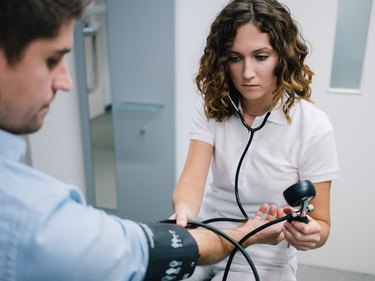
Gravity is your friend. It keeps you, and everything around you, from simply floating off into space. But one aspect of gravity does pose a significant and almost constant challenge: the need to keep your blood pressure stable when you go from lying down to standing up.
Video of the Day
Video of the Day
The Autonomic Nervous System in Action
"It's all about the veins," says John Osborne, MD, PhD, director of cardiology at State of the Heart Cardiology in Southlake, Texas, and a spokesperson for the American Heart Association. "When we get up out of a chair or bed, our body has to immediately work against gravity to make sure that the blood that would otherwise pool in the legs gets back up to the heart and head."
"And that calls for a mechanism that can instantaneously constrict the veins and divert the blood to where we want it to go," Dr. Osborne says. Absent that sort of sudden sharp course correction, he notes, you're liable to simply collapse.
But not to worry: "There's actually a very complex mechanism to take care of that," he explains. "And it's one that acts quite quickly — in seconds or less." It's called autoregulation, and it works, Dr. Osborne says, by enlisting your autonomic nervous system (ANS) to kick into high gear whenever you rise from a seated or lying down position.
As observed in a study published in May 2014 in Circulation Research, the ANS plays a central role in regulating key body functions, including blood pressure and heart function, both while your body is at rest and when it needs to respond to outside stimulation.
And, in the case of having to manage blood pressure when you stand up, Dr. Osborne explains that the ANS handles the dilemma by triggering special cells to issue neurologic signals that instruct your blood vessels to constrict. It's these special cells, called baroreceptors, that the Mayo Clinic credits with stabilizing your blood pressure and saving the day.
A Complication: Orthostatic Hypotension
Though the process almost always unfolds seamlessly and in the blink of an eye, that's not always the case. For example, you may have a condition called orthostatic hypotension (or postural hypotension), which the Mayo Clinic describes as a form of low blood pressure that strikes specifically when you stand up from a seated or supine position.
The dizziness, lightheadedness, blurred vision, weakness, nausea or confusion that you may experience as a result is often just occasional, mild and short-lived, lasting for just a few minutes or so. The Mayo Clinic notes that, in such cases, the cause — for instance, you're dehydrated, have low blood sugar or are rising after a prolonged time spent in bed — is usually nothing to be concerned about.
Still, if you start to experience these symptoms with increasing frequency, it could be a sign of a number of serious underlying conditions, the Mayo Clinic warns, which may include heart and endocrine problems or nervous system disorders such as Parkinson's disease. Chronic orthostatic hypotension could also source back to certain medications you may be taking, like diuretics, beta blockers, calcium channel blockers and angiotensin-converting enzyme (ACE) inhibitors.
"If it's very severe or a repeating issue, there may be something going on that needs to be checked out," Dr. Osborne says.
"But it could also simply be a sign of age," he says. "It's actually a pretty common problem as we get older. Our nervous system is not as sharp as it once was. In fact, everyone will likely experience this kind of dizziness, at least to a mild degree, as they age, which is why we always tell our more mature patients to be careful not to get up out of a chair or bed too quickly."
Is this an emergency? If you are experiencing serious medical symptoms, please see the National Library of Medicine’s list of signs you need emergency medical attention or call 911.